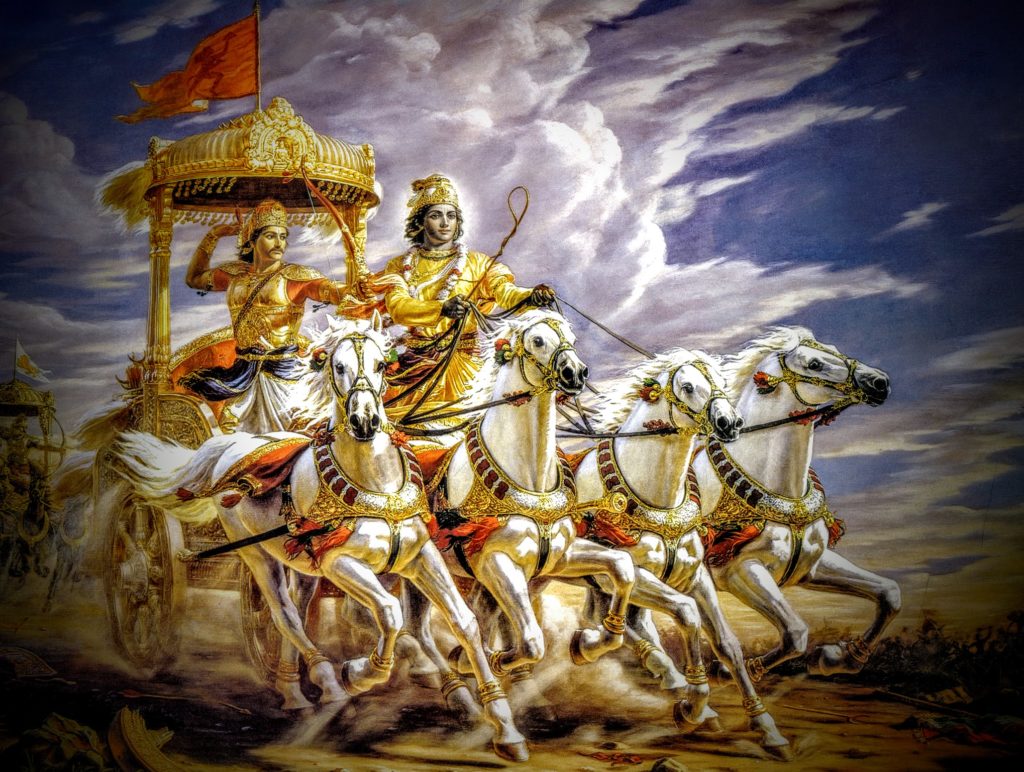 Have you ever had moments when you felt stuck in your tracks, unable to decide, caught between alternatives you didn’t like – or great options that seemed equally appealing?
Have you ever had moments when you felt stuck in your tracks, unable to decide, caught between alternatives you didn’t like – or great options that seemed equally appealing?
Or, as you planned your career, have you felt stymied by the question: “What am I really meant to do?”
We probably all have. I learned more about navigating these stuck times during my recent trip to India, where I was introduced to the Bhagavad Gita, India’s epic, sacred text.
Now I call them “Arjuna moments”.
The journey of finding your calling
When I was growing up, I thought knowing my calling was something I needed to have handled by my late twenties.
Life has taught me otherwise.
During my twenties, I tried to figure out what I wanted to do. Then, in my 30s and 40s, I rushed up the mountain of vocation, working feverishly to make my mark on the world and be someone.
By the time I hit 50, something had shifted. I no longer worried as much about wanting to be someone (although this seductive concept can still grab me). What I cared more about, as I inched towards sixty, was making sure that I was doing my real work, the work I was uniquely meant to do, not just following in the stream of the work I had gotten used to doing.
I’ve read a lot of books about finding your calling, but as I prepared to go to India I found one that was truly helpful: Stephen Cope’s, The Great Work of Your Life: A Guide for the Journey to your True Calling. It was also my introduction to the Gita.
The question of dharma
Cope, who has directed the Kripalu Yoga Center in Western Massachusetts, shared examples of people like myself who struggled, in mid-life, with questions about their callings. The professionals he described felt trapped between paths that had brought them success, and the deeper pulls of their hearts.
They were struggling to understand their dharma, a yogic concept Cope defines as right work or sacred duty.
I think Dr. Seuss would have called it, “that which is you-er than you”.
To bring the concept of dharma alive, Cope describes how some well known luminaries like Jane Goodall, Mahatmas Gandhi, and Henry Thoreau came into their callings. And he takes us back to the wisdom of the Bhagavad Gita, to explore how its legendary hero, Arjuna, discovered his dharma.
On the battlefields with Arjuna
In the opening scene of the Gita, Arjuna, the warrior prince, is facing a dilemma not unlike our own.
A proud leader of the Pandavas, and a successful warrior, Arjuna is ready to do battle with the evil Kauravas. But before he does, he surveys the battlefields of Kurukshetra, where the two armies are lining up to fight.
Arjuna is gorgeous, standing tall in a golden chariot, with his dark skin and dark hair flowing out from beneath his helmet. I imagine him sweating in the hot Indian sun, his bulging muscles glistening, his head held high. Next to him, holding the reins of their four white steeds, is his youthful looking friend, Krishna, a deity disguised as a charioteer.
Arjuna is a picture of confidence until, surveying the fields, he is suddenly derailed. In the ranks of the enemy Kauravas, he sees the unexpected: the eyes of friends and relatives he has loved.
He knows that he cannot kill family and friends – so certainly he must not fight! But he also knows that as a warrior and leader of the Pandavas, it’s his duty to fight and he is honor bound to do so.
That’s what I’d call a pickle!
Arjuna drops to his knees in the chariot, crippled by this new uncertainty. He seeks counsel from his good friend Krishna, hoping for an easy way out of the situation and a way to justify walking away from battle.
Krishna says nothing.
Eventually, to help his buddy, Krishna launches the discourse on dharma and right living that is at the heart of the Bhagavad Gita.
I won’t try to go further into this amazing work that scholars have studied over the millennia. I’m content to have my own relationship with Arjuna.
Even though I may seem nothing like this virile warrior from a different culture, I identify with his dilemma. When faced with difficult decisions about my path, I also freeze up. I wonder where to go for answers about what to do. Not to old models of success. Not to friends or relatives. Not to what the market is telling me. Reading the Gita, I learn that I will need to find the answers within while I continue to search for who I am.
(Incidentally, the Gita isn’t just about guys fighting wars. Mahatma Gandhi considered it his favorite text, knowing that the real war we are fighting is the one within our hearts.)
My recent Arjuna moment…

In December, I went to India to attend a world leadership dialogue on how the Bhagavad Gita applies to today’s leadership. Staring for four days at the conference’s huge banner of Arjuna and Krishna in their chariot, I felt Arjuna start to enter my blood.
After the conference, I went to Mumbai to offer two workshops on Business Storytelling to the Mahindra Group. I was more than thrilled with this opportunity, knowing Mahindra is a world leader in corporate social responsibility, a global corporation that takes its values and stories seriously.
The morning of my first workshop, I woke early. I staggered to the window, and opened the curtains to the red sky and dusty dawn of Mumbai. I felt good. I had held a head cold at bay, my materials were prepared, and I was ready to teach.
As I sat down to meditate, I glanced at my phone. A text from my sister flashed on the screen. “Sorry to tell you but Mom had a stroke yesterday. She’s quite unresponsive. I assume you have no objection to my ordering hospice?”.
I stopped in my tracks. My mother was dying on the very day I was scheduled to teach on the other side of the world? I called my sister to get a little more information and then sat down to think. I pondered the options: rush home to be with my (possibly) dying mother? Or proceed as planned and teach my workshops – and leave for Seattle on the weekend as planned?
Both options had merit. I closed my eyes and thought of Arjuna. My decision became clear: I would teach the classes.
I decided and took action, knowing that I’d have to live with the consequences of my actions, ones I couldn’t predict. Striving for the perfect decision, as I have so often done, would have left me unfocused and tortured – like Arjuna on the floor of the chariot.
Did I make the “right” decision? Who knows. I made it back to Seattle in time to see my Mother (who is still alive today although partially paralyzed and bedridden). But seeing her was not guaranteed.
And now
Thanks to the Gita, Stephen Cope, and my wise friends in India, I’m approaching the question of my calling differently these days. My calling is not about being someone or proving something. My calling is not about fitting a picture of what I am supposed to be doing. It’s not about amassing a fortune.
Instead, the work is to sync up the inner me with my outer activities, through myriad small decisions and actions. I strive to hear my heart and discover what to do with what the poet Mary Oliver called my “one wild and precious life”.
I pray for the strength of Arjuna and the wisdom of Krishna as I continue along the way.










5 Responses
Enjoyed reading the blog and the most important lesson I learned from Gita was that our actions shouldn’t be governed by reactions of others. Trying to do right thing amidst uncertainty and fog of clouding mind always test one’s courage, convictions and finding comfort within one self. Most importantly, we all are accountable for our actions to ourselves,develop empathy for conflicts with competitive options and enhancing capacity for allowing the suffering within to let it go after the decision.
Thank you for enlightening us.
Raj Lal
CVThoracic Surgeon ( Emeritus)
Oak Brook, IL
P.S. Hope, you remember me.
I more than remember you Dr. Raj – you were one of our best students when we were working with transformational leadership at Central Dupage Health Systems – a physician who really understood the power of transformational leadership and working from the inside out. Even though you are retired from your practice, I am sure you are continuing to inspire!!!
Love this, Sally! I downloaded the sample of “The Great Work of Your Life” to my iPad some time ago but still haven’t gotten to that one – I will now! I’ve always struggled with understanding the Bhagavad Vita, so thank you for clarifying much of its meaning. Very inspiring post – and I’m glad your mother is still with you. Looking forward to seeing you soon.
Hi Sally,
I have been pondering over the question “Do I know my Calling”.
I do not know if I have found the ‘right’ answer to this very important question.
However I do look back on those moments in my life when I felt extremely energised or top of the world.
I have been most energised when I have undertaken a task / project / activity that in common parlance would be considered impossible. Though I have felt great when I was able to accomplish the desired task, however, I will still rank the time higher when I have chosen to attempt some thing seemingly impossible.
In fact this thread runs through irrespective of the field of activity. Be it professional task, improving health, or any other activity.
I request your comments on this.
Regards
Ravi
Thanks for your thoughts, Ravi. I think there is something about attempting the impossible that gives us a heightened sense of who we are and, at times, a sense of our destiny.
At the same time, I think we can also find ourselves in the non-impossible when we get totally absorbed by something we love. When I was in my late teens, I felt that way about photography when I’d spend hours in the darkroom. And more recently, I have felt that with some of my writing, particularly when I’m creating something I will perform. I’ll have moments when I think, no matter what happens when I get on stage or perform before a group, I know that this is my right work. I feel so alive – this is me.
That “I feel so alive” moment tips me off to part of my calling.
It sounds like you have this when you’re working on the impossible.
Back to you for your thoughts!
Best,
Sally